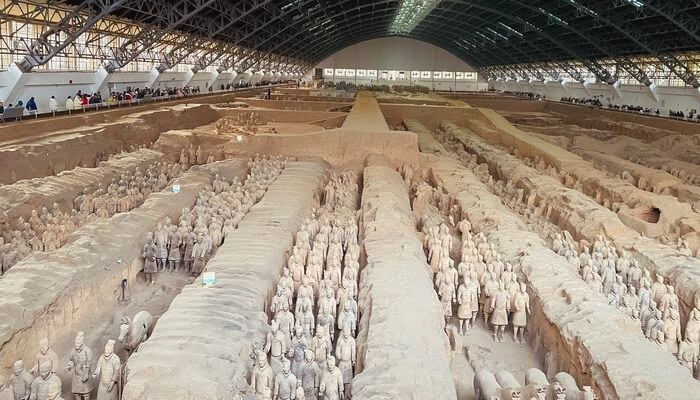Xi’an 3 days itinerary – Top Places to Visit in Xi’an
When I began planning my trip to China, Xi’an was a definite inclusion on my itinerary due to the famed Terracotta Warriors. However, Xi’an, as the former capital governed by 13 dynasties, offers far more to unveil. In my 3-day Xi’an itinerary below, I’ll delve into the city’s rich history and showcase its diverse attractions. A visit to Xi’an also provides insight into one end of the renowned Silk Road, showcasing a pivotal trading connection with the West where Arabian and Persian traders congregated during their journeys for commerce and diplomacy with the emperors.
Xi’an, although sprawling, surprisingly proves easy to navigate. Within my China travel itinerary, allocate three days to explore Xi’an thoroughly.
By following my 3-day Xi’an itinerary, you’ll steer clear of missing essential sites and maximize your experience within a limited timeframe. From ancient civilizations to illustrious dynasties, Xi’an serves as a treasury of Chinese history and an indispensable stop on any travel agenda. In this guide, I’ll outline how you can encompass city’s major highlights over a compact 3-day Xi’an itinerary.
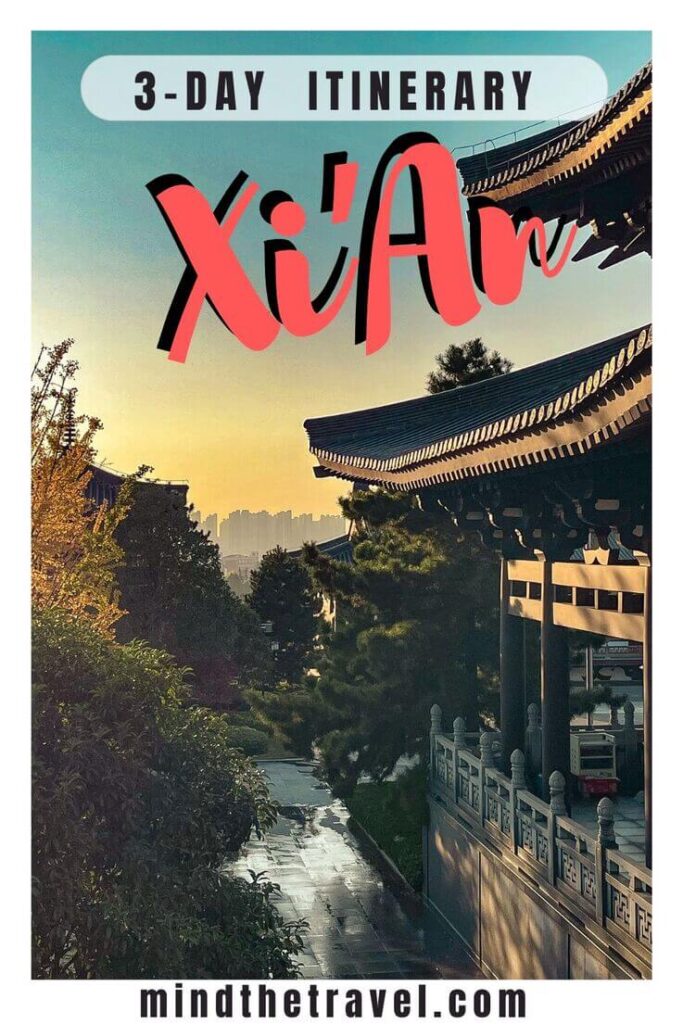
Xi’an 3 days itinerary – Top Places to Visit in Xi’an
This Xi’an itinerary presents a detailed plan to explore the city’s top attractions, offering suggestions for extended stays, day trips, local cuisine, and insider tips.
During my visit amidst the Qingming Festival (Tomb-sweeping Day) in April, I prioritized a trip to the Terracotta Warriors on the first day. Nonetheless, you have the flexibility to interchange the days, immersing yourself first in the city and its cultural essence.
How to Reach Xi’an?
By High-Speed Train
If you are traveling from Beijing, the high-speed train is recommended for a convenient and scenic journey. This option offers a comfortable and efficient mode of transportation to Xi’an.
By Plane
For those coming from Shanghai, flying to Xi’an is a faster alternative compared to the train route. A plane journey provides a time-saving option for travelers embarking from Shanghai to reach Xi’an promptly.
Ground Transportation
Upon arrival at Xi’an airport, various transportation options are available to reach the city center.
Is Xi’an Worth a Visit?
Xi’an stands as a city of immense historical significance, once serving as the capital for 13 Chinese empires and kingdoms.
Its rich heritage, political importance, and economic prowess make Xi’an a must-visit destination for travelers seeking a deep dive into China’s past.
The city offers a diverse range of experiences, attractions, and cultural insights, making it a compelling destination for those eager to explore the historical tapestry of China.
Xi’an’s historical depth and cultural wealth make it unquestionably worth a visit for anyone fascinated by China’s captivating history and heritage. I wholeheartedly endorse a visit.
How Many Days in Xi’an Needed, How Long to Spend
Ideal Length of Stay
To cover the main attractions in Xi’an comprehensively, plan for a minimum of 2 days. This duration allows you to explore key sites and immerse yourself in the city’s cultural essence.
Recommended Stay
I suggest dedicating 3 to 4 days in Xi’an if you wish to delve deeper into its offerings, including day trips as outlined in my itinerary. This extended timeframe provides ample opportunity to absorb the city’s historical and cultural treasures at a leisurely pace.
Day 1 of Your 3 Days in Xi’an Itinerary
Commence your day with a visit to the renowned Terracotta Warriors and conclude it in the vibrant heart of the city.
Terracotta Warriors
Revered as the most significant archaeological find of the 20th century, the Terracotta Warriors stand as a UNESCO World Heritage Site.
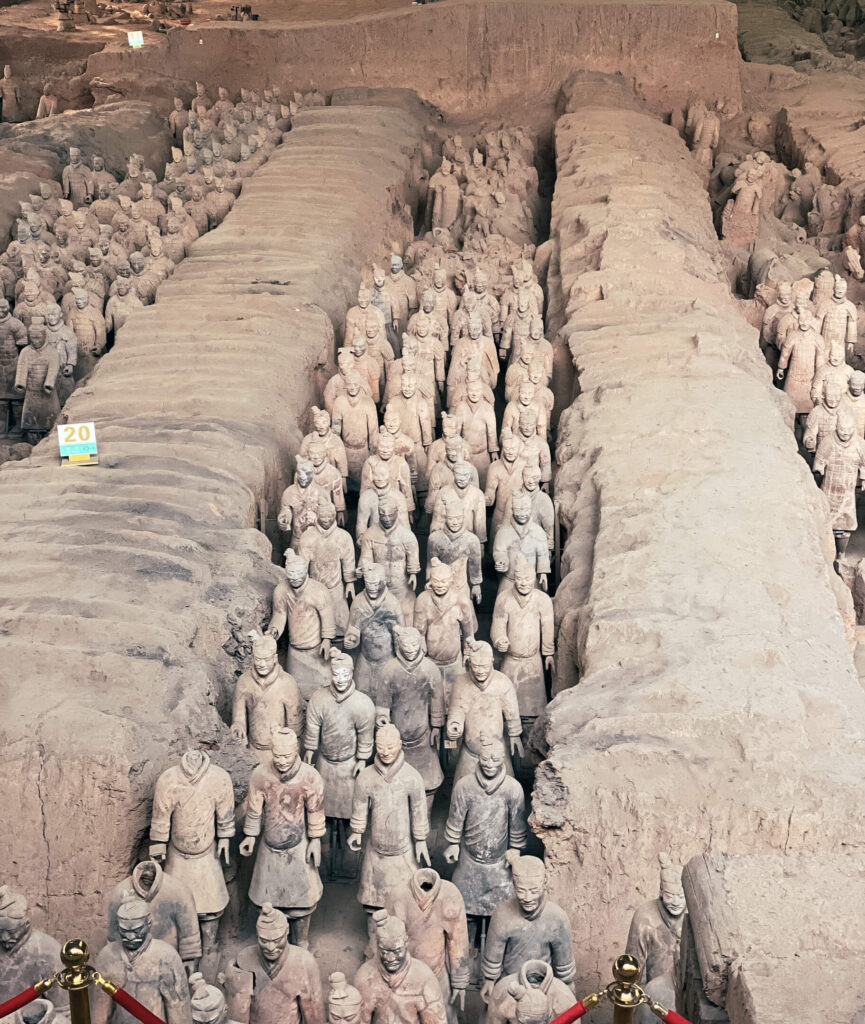
Crafted to protect Emperor Qin Shi Huang in the afterlife, these clay warriors and horses symbolize the legacy of the Qin Dynasty.
The intricate masterpiece, taking 11 years to complete, was unearthed by farmers seeking pottery ruins in 1974.
Terracotta Army Pits Overview
Pit #1
Terracotta Army Pit 1 is an expansive east-west rectangular pit, spanning 230 meters (252 yards) in length, 62 meters (68 yards) in width, and 4.5 to 6.5 meters (15 to 21 feet) in depth.
This is the largest pit, housing over six thousand life-sized terracotta warriors and horses, is the first and most renowned discovery.
Pit #2
Pit 2 measures 96 meters (315 feet) in length and 84 meters (276 feet) in width. It features four distinct units housing diverse troop types such as cavalry, archers, chariots, infantry, and formations that mirror military strategic deployments.

This pit also displays depictions of wounded warriors and deceased soldiers.
Pit #3
Serving as the command center, this smallest pit was intended for high-ranking officials. Statues of officials standing in rows along the passageways leading to the main hall offer an intriguing glimpse into ancient command structures.
Getting to Terracotta Warriors from Xi’an
To reach the Terracotta Warriors from Xi’an, consider booking a tour with hotel pick-up for convenience. Alternatively, taxis are available, but given the site’s location nearly 40 km from Xi’an’s city center, taxi fares may be relatively high. Plan your transportation accordingly to ensure a seamless journey to this archaeological marvel
The Best Time to Visit Terracotta Warriors
Optimal Seasons
Spring (April to May) and Autumn (September to October). These months offer mild temperatures and less rainfall, providing pleasant conditions for exploring the Terracotta Warriors site comfortably.
Avoid Peak Seasons
Summer (June to August). While summer brings warmer weather, it also sees increased crowds and higher temperatures, which can be challenging for extended outdoor visits.
Winter (November to February). The colder winter months may not be ideal for exploring the site, particularly due to potential chilly conditions and reduced daylight hours.
Considerations
Weekdays: Visiting on weekdays can help avoid the larger weekend crowds, allowing for a more relaxed and immersive experience.
For an optimal experience, consider visiting early in the morning, ideally before 9 am, as most major tours tend to arrive around 10 am.
I personally explored the site on a Tomb-sweeping Day and found that being there early helped me avoid significant crowds. In fact, I breezed through security and entrance procedures within just a few minutes, allowing for a more seamless and relaxed visit to the Terracotta Warriors.
Qin Shi Huang’s Mausoleum Site Park (Lishan Garden)
The Terracotta Warriors, a relatively recent archaeological marvel, continue to reveal new relics to this day.
Among the notable discoveries is the Mausoleum of Emperor Qin Shi Huang, the figure safeguarded by these iconic warriors.
Situated alongside other significant sites like the ritual sacrifice pits and the Museum of Terracotta Acrobatics, this mausoleum offers a fascinating glimpse into ancient history.
Despite its discovery, Emperor Qin’s tomb remains untouched and is likely to remain so.
The park’s curator aims to preserve the tomb, anticipating that future technological advancements may provide a way to explore its contents without disturbing the resting souls within—a tantalizing prospect indeed.
Historical records and contemporary analyses suggest that the tomb’s inner sanctum potentially houses valuable gems, rivers of mercury flowing amidst mountains of bronze, painting a vivid picture of the treasures that lie within this enigmatic structure.
The Bell Tower
Constructed in 1384, the Bell Tower has long served as the focal point of the ancient capital, marking its geographic center.
Originally designed to oversee the surrounding terrain and provide early warnings of potential attacks from rival factions, the tower symbolized dominance and vigilance.
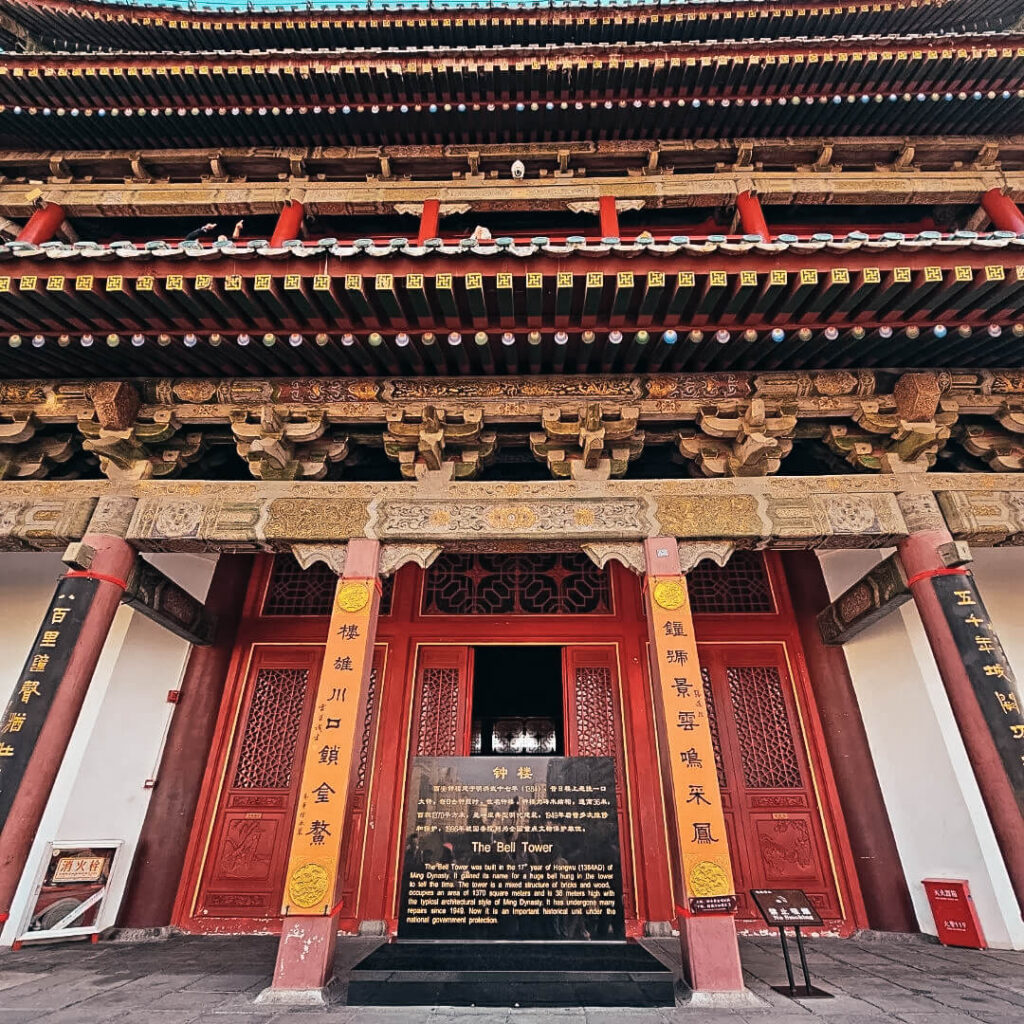
Initially positioned alongside the Drum Tower of Xi’an on the city’s central axis, the Bell Tower’s significance endured as Xi’an expanded.
In 1582, recognizing the city’s shifting center, the tower was relocated 1,000 meters east from its original location, preserving all parts except the base in their original form.
The Bell Tower’s allure lies in its striking aesthetic, blending the contrasting hues of a grey square base, dark green glazed tiles, and a gilded roof. Particularly enchanting at dusk when illuminated, the tower stands out as a captivating highlight on this 3-day Xi’an itinerary.
The Drum Tower
Originally constructed in 1380 during the Ming Dynasty (1368-1644), the Drum Tower’s architectural influences extend beyond the Ming era, incorporating elements from the Tang and Qing Dynasties.
Adjacent to the Bell Tower, you’ll find the Drum Tower, separated by the fittingly named Bell and Drum Tower Square.
Renowned for its collection of drums, this tower pays homage to its historical role as a timekeeper. In ancient China, these drums served not only to mark time but also as vital alarms during emergencies.
Notably, the tower was ingeniously crafted without the use of iron nails, showcasing impressive engineering prowess.
Ascend to the tower’s summit for breathtaking panoramic views of the city, offering a perfect vantage point to immerse in Xi’an’s scenic beauty.
Great Mosque of Xi’an
Nestled in the heart of the Muslim Quarter, this Great Mosque stands out with its distinctly Chinese character. Serving as a pivotal Islamic landmark, it presents a unique amalgamation of Confucian and Buddhist temples you’ve encountered thus far.
Remarkably, this mosque stands as China’s oldest and largest, defying conventional mosque aesthetics by eschewing minarets.
Housing five courtyards and 20 edifices, it seamlessly blends Islamic and traditional Chinese architectural styles. Dating back to 742 during the Tang dynasty, this UNESCO World Heritage Site has undergone expansions across various dynasties, embodying a tapestry of historical periods.
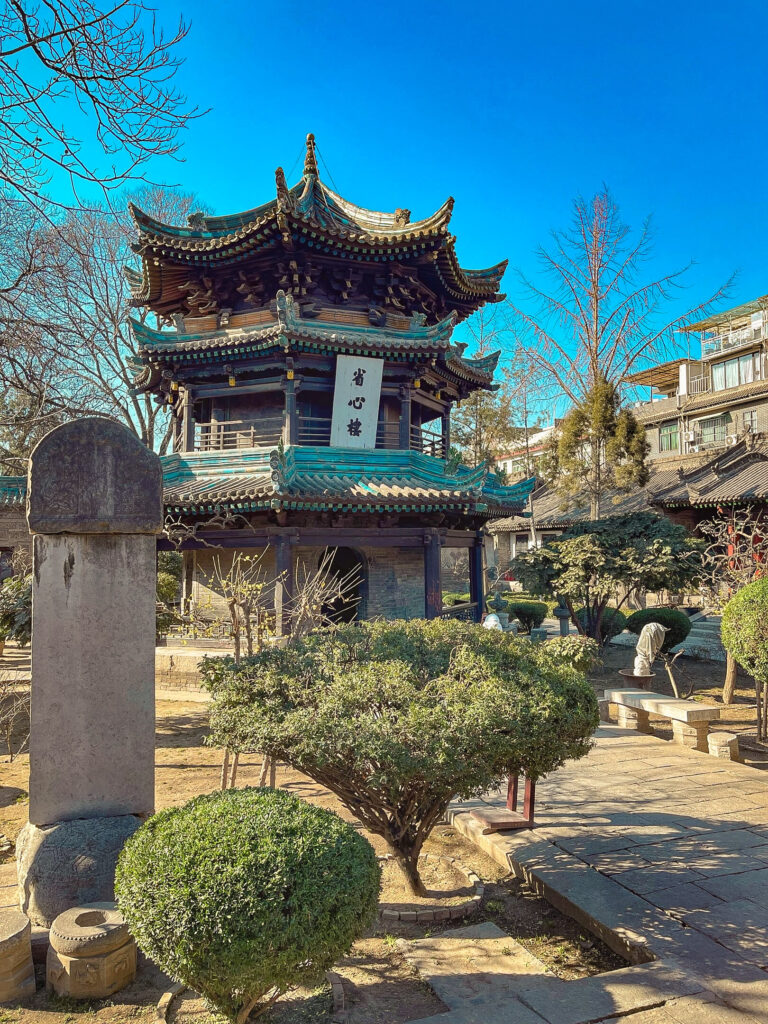
To locate this architectural gem, those in the city center can conveniently stroll along the main street (East Street or West Street, depending on your direction).
For those arriving from afar, taking metro line 2 and alighting at Zhonglou Station (Bell Tower) via Exit B provides a seamless path to this iconic site, facilitating easy access to its cultural splendor.
The Muslim Quarter (Beiyuanmen)
Discover the thriving Muslim community in China, notably thriving in Xi’an, where an entire quarter of the city is dedicated to this dynamic neighborhood.
The Muslim Quarter houses more than 20,000 descendants of foreign diplomats and Silk Road merchants who initially arrived for business and settled permanently.
A quintessential 3-day Xi’an itinerary should include a visit to the Beiyuanmen Muslim Market, a hub famous for its array of street food and unique souvenirs.
Lined with Ming and Qing Dynasty-style buildings hosting family-operated establishments, this market entices visitors with authentic handcrafted Muslim cuisine.
Indulge in specialties like mutton stew with crumbled bread, fried rice with pickled Chinese cabbage, and flame-roasted mutton or lamb.
For an enchanting evening experience, consider attending a musical performance near the Giant Wild Goose Pagoda. A memorable and visually stunning spectacle.
Arrive at least thirty minutes before the show to secure the best view and fully immerse yourself in this captivating performance.
Day 2 of Your 3 Days in Xi’an Itinerary
Commence your second day in Xi’an by embarking on an adventure along the city walls. Opt for a thrilling and enjoyable experience by renting bicycles to ride atop the walls.
It’s highly recommended to begin early in the morning to avoid the bustling crowds. Doing so will ensure a smoother biking journey along this historic structure.
Xi’an City Walls
Encircling the heart of Xi’an stands a 14 km long city wall erected under Emperor Zhu Yuanzhang in the 14th century for defensive purposes. It is a must-visit on your 3-day Xi’an itinerary.
Among the gates granting access, the most well-preserved sections of the wall are accessible through 18 gates, each operating on distinct schedules.
For a thrilling biking experience, bicycles can be rented solely at the primary four gates: North, South, East, and West.
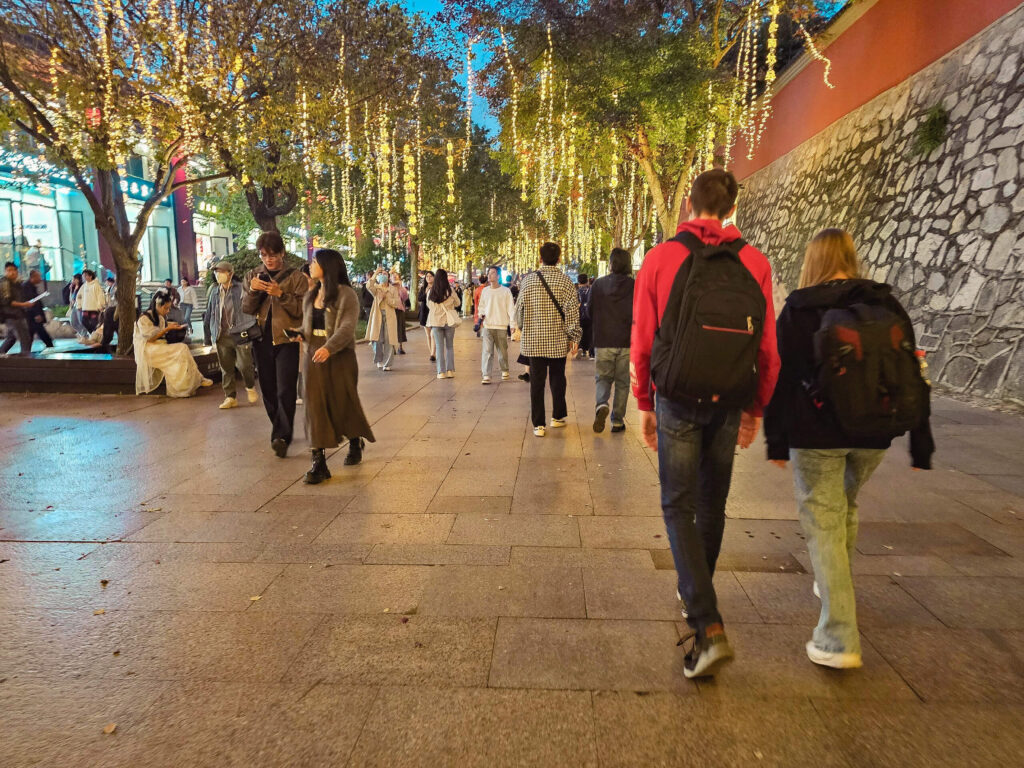
The South Gate (Yongning Gate) serves as a prominent entry point to access the wall, offering a time-honored experience. Additionally, visitors can explore two museums within the barbican and the archery tower of the South Gate.
These gateways also house watchtowers that historically dictated the city’s opening and closing times. Take your time to relish this engaging activity, pausing along the way to capture memorable photos. You can opt to cycle the entire span or halt at the next gate, offering flexibility in your exploration.
Noteworthy among the gates is the Southern Gate, where you can witness the changing of guards at scheduled intervals (09:30, 15:30, and 18:40), followed by a chance for photographs.
Arts Street (Shu Yuan Men)
After concluding your Xi’an City Wall excursion at the South Gate, don’t miss strolling through the renowned Arts Street.
Shu Yuan Men Street hosts a collection of shops showcasing traditional handcrafted items, catering to those seeking authentic art pieces.
This marketplace boasts a variety of Oriental paintings in diverse styles, making it a treasure trove for art enthusiasts.
Visitors keen on acquiring genuine calligraphy scrolls can browse through the numerous stores offering these timeless pieces.
Beyond calligraphy supplies, patrons can explore a range of offerings. These include jade articles, jewelry, antiques, and folk artifacts, adding to the market’s cultural richness.
Giant Wild Goose Pagoda
Xi’an proudly preserves its ancient heritage, with the Giant Wild Goose Pagoda standing as a prominent symbol of the city’s rich history.
Nestled within the Da Ci’en Temple complex, this UNESCO World Heritage Site holds immense significance for Buddhists and history enthusiasts alike.
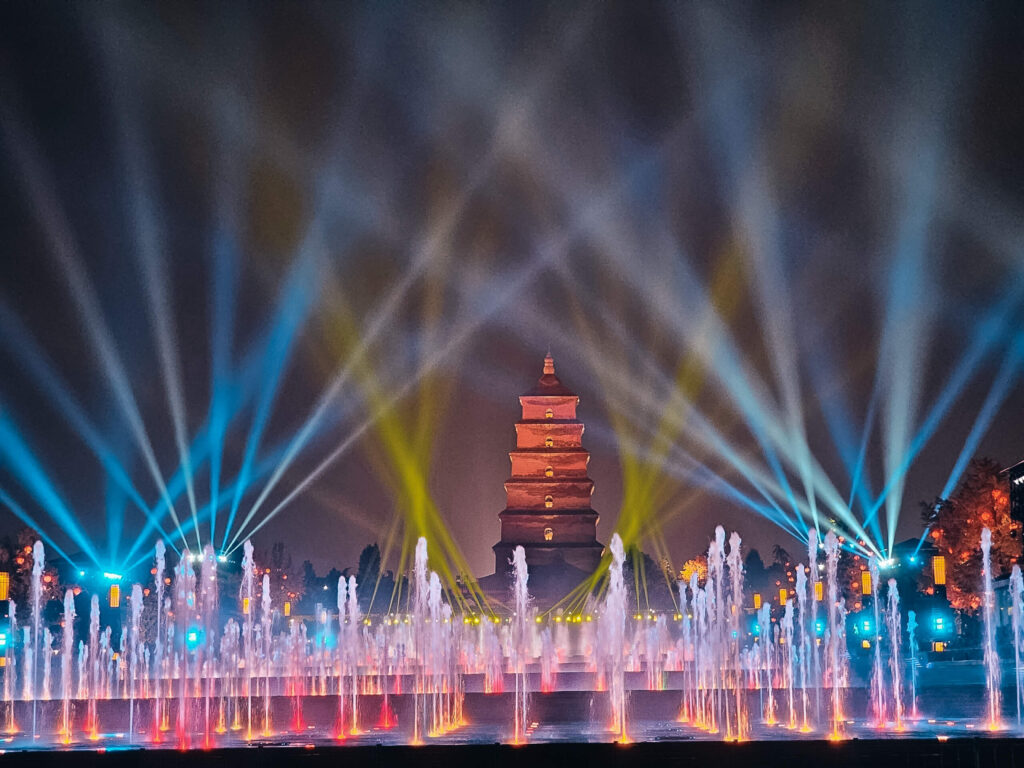
Giant Wild Goose Pagoda was initially constructed during the Tang dynasty in 652. It served as a repository for Buddhist texts brought from India by Xuanzang.
Xuanzang was an esteemed Buddhist monk who amassed 1,335 sutras, requiring translation from Sanskrit to further propagate Buddhist teachings.
Curious about its name? The legend of the Giant Wild Goose Pagoda unfolds a tale of compassion. As per the narrative, a group of monks, unable to find meat for consumption, sought divine intervention.
Observing a flock of geese passing overhead, they invoked Buddha’s mercy. Subsequently, the leading goose plummeted to the ground, interpreted as a sign to forsake meat consumption.
In honor of this event, a pagoda was erected at the site of the felled goose, forever altering the monks’ dietary choices.
Venturing to the North Square reveals one of Asia’s largest fountains, offering a mesmerizing water spectacle every evening. Adjacent to this grand display lies the Great Tang Mall, adding a modern touch to the historical surroundings.
To make the most of your visit, aim to arrive before closing hours. Doing so will ensure ample time to relish a leisurely evening stroll amidst musical performances and delectable cuisine.
Small Wild Goose Pagoda
Spot a familiar sight? The resemblance between the square-based Small Wild Goose Pagoda and its grand counterpart, the Giant Wild Goose Pagoda, prompted locals to rename it, acknowledging its likeness.
This UNESCO Heritage Site preserves its legacy from the Tang Dynasty, offering visitors a peaceful retreat within its verdant park surroundings.
While the Small Wild Goose Pagoda may not enjoy the same level of fame as its larger sibling, it exudes tranquility and charm, contrasting with the bustling energy of its renowned counterpart.
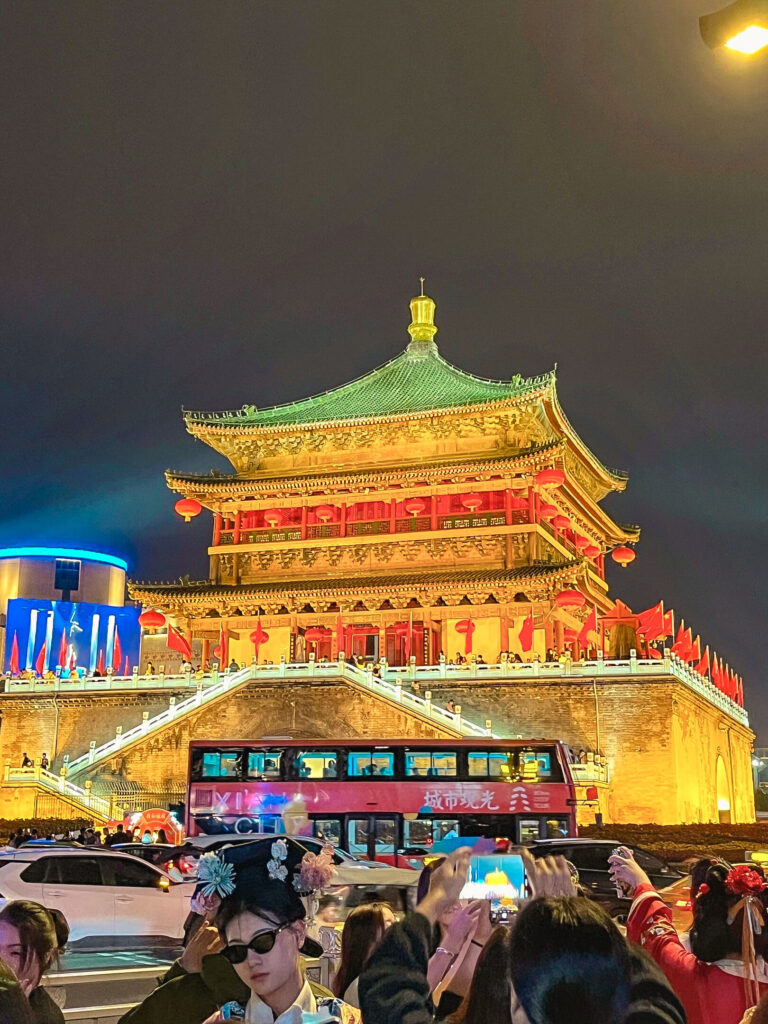
This pagoda, like the Giant Wild Goose Pagoda, played a significant role in the propagation of Buddhism in China. Housing Buddhist scriptures brought from India, it contributed to the fusion of Buddhism with Han culture.
Dating back over 1,300 years to the Tang Dynasty, the Small Wild Goose Pagoda stands as one of the best-preserved pagodas of its time.
To access this historical gem, board metro line 2 and alight at Nanshaomen Station (Exit A1 or A2).
Cap off your day with a memorable dining experience at a theater featuring the enchanting Tang Dynasty Show. Immerse yourself in the magic of traditional performances as a fitting conclusion to your exploration of Xi’an’s cultural life.
Day 3 of Your 3 Days in Xi’an Itinerary
Opting to dedicate your final day in Xi’an to exploring the city’s famous parks is a splendid choice.
For a day filled with natural beauty and historical charm, consider venturing to the Tang Lotus Paradise Park and Daming Palace National Heritage Park.
These two iconic destinations promise a memorable continuation of your 3-day Xi’an itinerary, offering serene landscapes and rich cultural heritage.
Daming Palace National Heritage Park
Functioning as a hub of power during the Tang Dynasty, Daming Palace served as a pivotal influence in the creation of the renowned Forbidden City, the most esteemed Chinese palace of its time.
Initially established by Emperor Li Shimin as a summer retreat for his father, Daming Palace featured two distinct zones:
- One dedicated to imperial court affairs;
- The other for residential and leisure purposes.
The separate Hanyuan Palace within the compound facilitated international exchanges and grand ceremonies. This is where ambassadors from around the globe were warmly received on New Year’s Day.
While a section of the park is open to visitors free of charge, access to the area encapsulating the ruins and Xi’an’s history requires an entrance fee.
Conveniently located just north of the city wall, the park is easily reachable via the metro.
Lotus Paradise Park
For a royal-themed addition to your 3-day Xi’an itinerary, consider the enchanting Tang Lotus Paradise. A former retreat for imperial family members, now transformed into the first ancient-style park dedicated to Tang Dynasty culture.

Revived in modern times, the gardens offer a glimpse into the opulence of imperial luxury, captivating visitors with a rich historical ambiance.
Within the park’s serene environs, a plethora of performances await. These range from the Imperial Costume Show and Chinese Kung Fu demonstrations to the mesmerizing Lion Dance and acrobatic displays.
Don’t miss the grand water fountain show, hailed as the largest of its kind in China. It leaves spectators in awe with its sheer magnificence and artistry.
Stele Forest Museum
Known by the name Beilin Museum, The Stele Forest showcases a captivating array of over 11,000 stone steles, epigraphs, and stone sculptures from bygone dynasties.
Through these exhibits, visitors are transported into the realms of ancient religions and lifestyles. They offer a distinctive insight into historical narratives.
The collection not only narrates the tapestry of Chinese history but also elucidates the nation’s interactions with foreign lands. It also presents a nuanced perspective on cultural exchange.
Amidst these revered relics, 19 esteemed groups stand out as national treasures. They embody the essence of historical significance and cultural richness preserved within The Stele Forest.
Guangren Lama Temple
Guangren Temple was established in 1705 to accommodate the Grand Lama of Tibet en route to Beijing to meet the emperor. It has retained its significance as the sole Tibetan Buddhist monastery in Shaanxi Province.
Serving as a testament to the harmonious cooperation and cultural exchange between Tibetan and Han communities, this temple stands as a beacon of unity.
Within its premises lie several halls, including the Mahavira Hall, the Sutras Keeping Hall, and the Bodhisattva Hall. Each of them embodies spiritual sanctity and historical reverence.
Places to Add to Your 3 day Xi’an Itinerary
If you find yourself with extra time to spare in the city, consider incorporating the following attractions into your Xi’an itinerary for a comprehensive experience of its surroundings:
Within the City:
- Forest of Stone Steles Museum;
- Shaanxi History Museum;
- Qujiangchi Relics Park;
Day Trips from Xi’an:
- Hukou Waterfall;
- Huaqing Palace and Lishan;
- Yuanjia Village;
- Yangling Mausoleum of Han Dynasty;
- Mount Hua Shan.
By including these sites, you can ensure that you make the most of your time in Xi’an. They help to avoid the oversight of key locations and to immerse yourself in the diverse cultural and historical tapestry that the city and its surroundings have to offer. I hope you have a memorable and enjoyable exploration!


